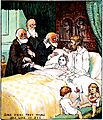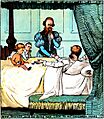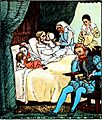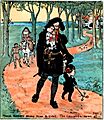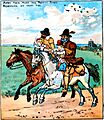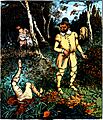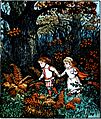Babes in the Wood facts for kids
Babes in the Wood is a classic English story for children. It's also a popular pantomime, which is a type of musical play often performed around Christmas. The phrase "babes in the wood" is now used to describe someone who is new and innocent in a tricky or dangerous situation.
Contents
The Traditional Story
The traditional tale is about two young children who are left alone in a forest. They sadly pass away, and robins cover them with leaves.
This story was first printed in 1595 as a simple song or poem called a broadside ballad. Its original title was very long: "The Norfolk gent his will and Testament and howe he Commytted the keepinge of his Children to his own brother whoe delte most wickedly with them and howe God plagued him for it."
The story has been told in many ways. It often appears as a Mother Goose rhyme. In 1879, the famous illustrator Randolph Caldecott created pictures for a book version of the ballad.
What Happens in the Story
The story begins after two young children's parents pass away. The parents leave their children in the care of their uncle and aunt. The uncle wants to get the children's inheritance, which is their money and property. He secretly plans to get rid of the children.
He tells his wife that the children are going to London for their education. But instead, he gives them to two men, asking them to take the children into the woods and harm them.
However, the two men disagree. One of them, who is kinder, refuses to hurt the children and instead harms the other man. The kinder man then tells the children he will return with food, but he never comes back.
The children are left alone in the deep woods. They wander around, holding hands, but they cannot find their way out. Eventually, they become very tired and hungry. They lie down and sadly pass away in each other's arms. According to the story, kind robins then cover their bodies with leaves.
Like many old tales, the story also tells what happens to the wicked uncle. He faces many troubles and difficulties as a result of his actions. Some versions of the story say the children are taken to Heaven. The story often ends with a warning for anyone who cares for orphans or other people's children to treat them well.
Babes in the Wood as a Pantomime
The story is also used for pantomimes. These are fun, musical plays, often performed around Christmas. Because the original story is quite short and can be sad, modern pantomimes often add parts of the Robin Hood story. They might include characters like Maid Marian to make the play longer and more exciting for young audiences.
Adaptations
Animated Short Film
The Walt Disney Company made an animated short film based on this tale in 1932. It was called Babes in the Woods. This film mixed parts of the Hansel and Gretel story by the Brothers Grimm with the Babes in the Wood tale. Disney's version also added a village of friendly elves and gave the children a happy ending.
Folklore and Legends
Local legends say that the events of Babes in the Wood really happened in Wayland Wood in Norfolk, England. People say the wicked uncle lived at a nearby place called Griston Hall. Some even say that the ghosts of the children still haunt Wayland Wood.
The village signs in Griston and nearby Watton show pictures from the story. In these folklore versions, the uncle dislikes having to care for the children. He pays two men to take the children into the woods and leave them there. The men cannot bring themselves to hurt the children, so they just abandon them. The children, unable to find food or help, eventually pass away in the woods.
Images for kids


